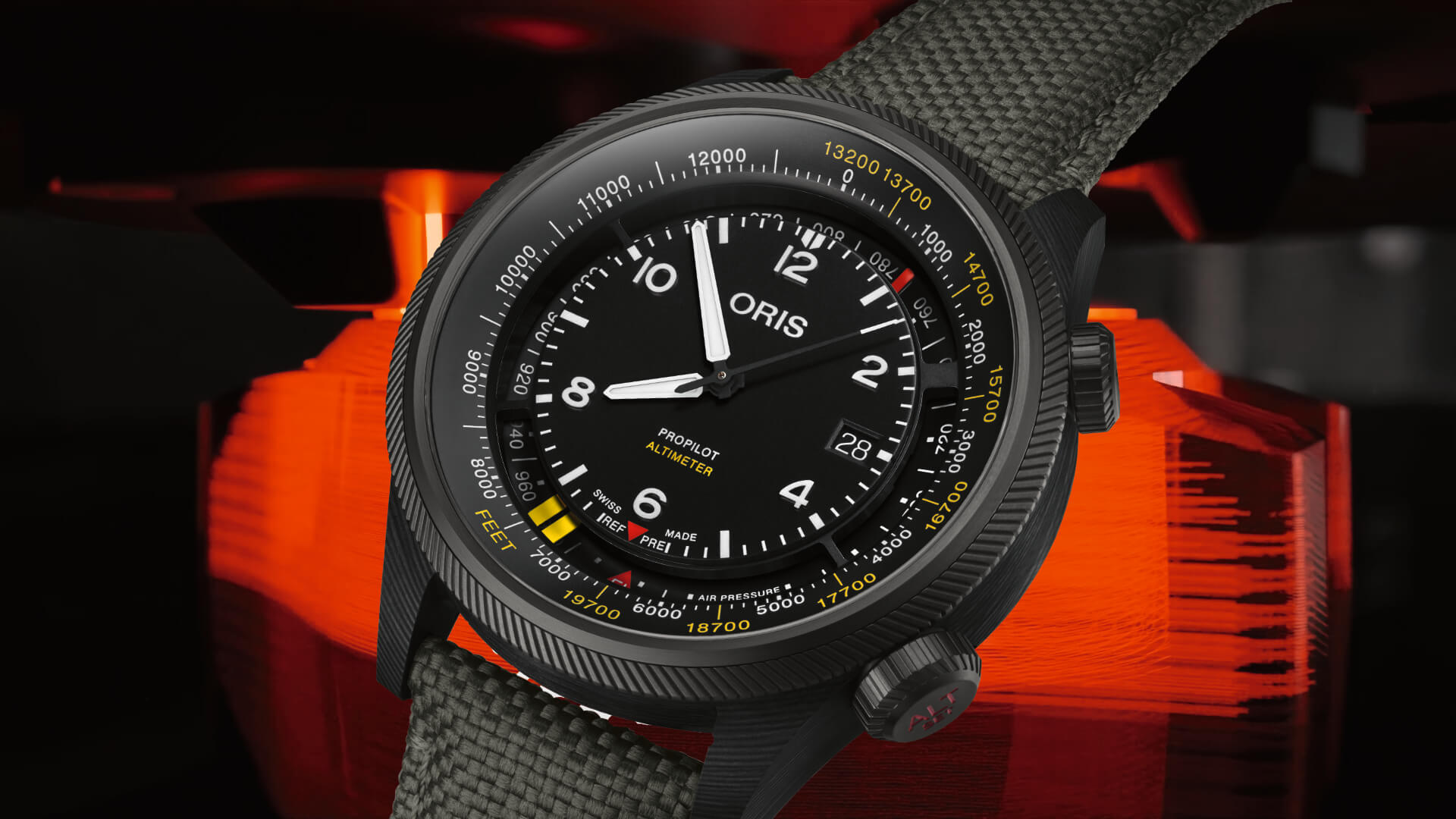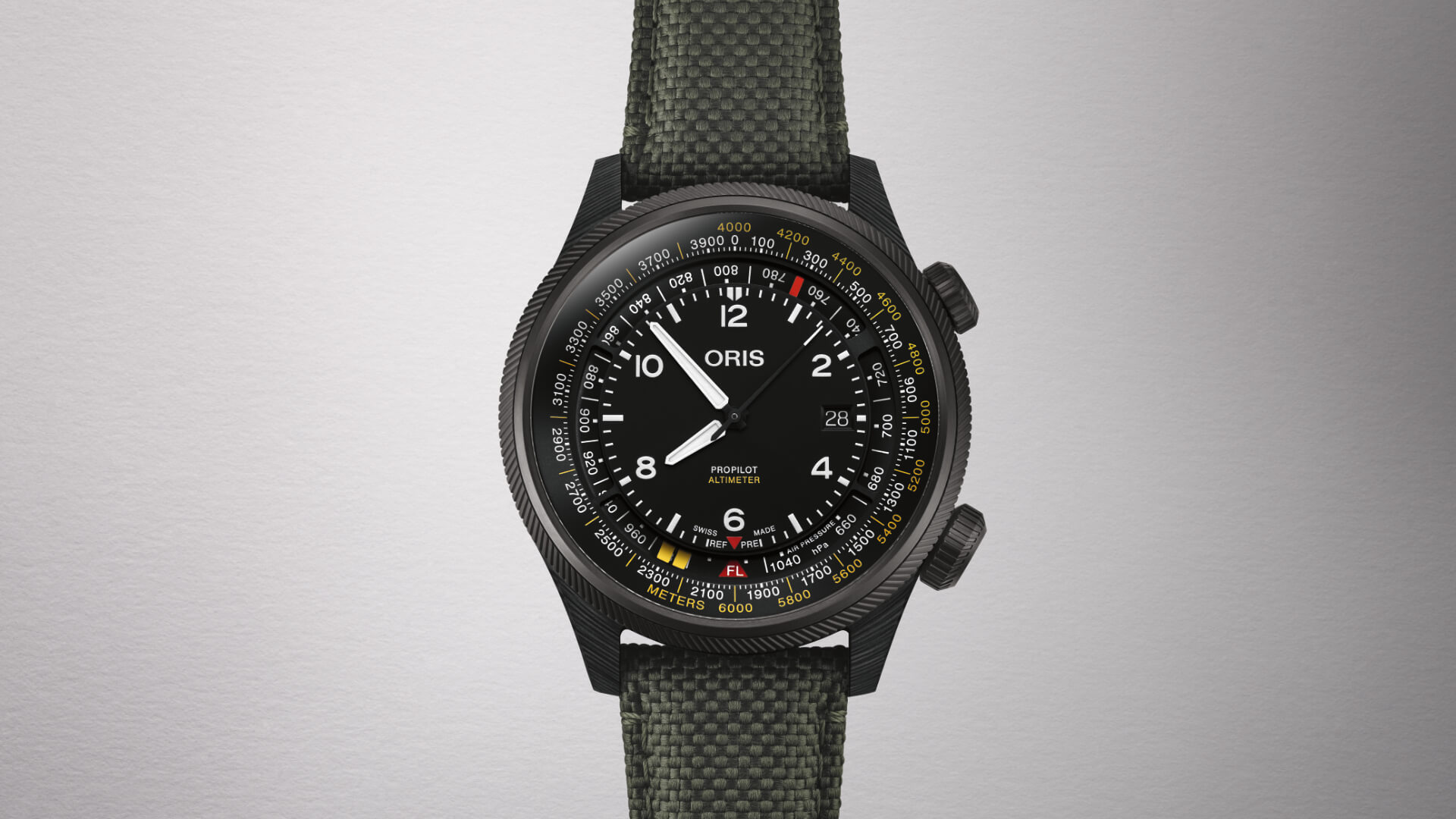 If you’ve only been into watches for a few years, you could be forgiven for thinking that Oris only makes a chunky modern diver and a handful of vintage-inspired pieces, each model available in a wide array of dials and cases. But before the Big Crown Pointer Date and the ProPilotX and the Diver’s Sixty-Five, Oris was beloved for the highly functional tool watches in its ProPilot collection. Over the past few years, aside from an occasional special edition, the ProPilot collection has languished in the background as newer, arguably more mass-market designs took center stage for the brand. That’s why I am genuinely excited to see that one of the most impressive ProPilots ever released is being updated. For Watches and Wonders 2023, Oris is finally getting back to (complicated) basics with a new blacked-out ProPilot Altimeter in carbon fiber composite.
If you’ve only been into watches for a few years, you could be forgiven for thinking that Oris only makes a chunky modern diver and a handful of vintage-inspired pieces, each model available in a wide array of dials and cases. But before the Big Crown Pointer Date and the ProPilotX and the Diver’s Sixty-Five, Oris was beloved for the highly functional tool watches in its ProPilot collection. Over the past few years, aside from an occasional special edition, the ProPilot collection has languished in the background as newer, arguably more mass-market designs took center stage for the brand. That’s why I am genuinely excited to see that one of the most impressive ProPilots ever released is being updated. For Watches and Wonders 2023, Oris is finally getting back to (complicated) basics with a new blacked-out ProPilot Altimeter in carbon fiber composite.
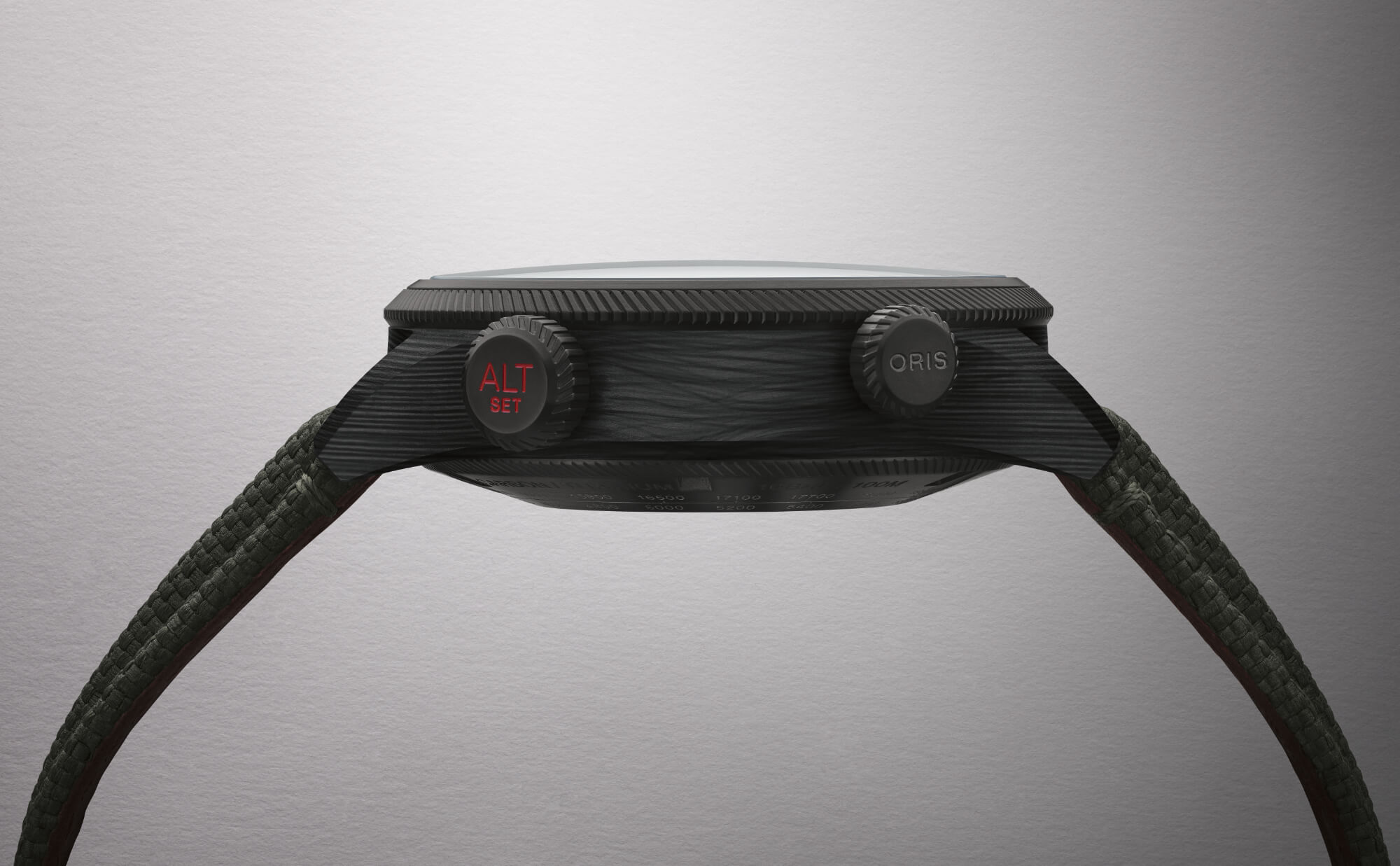 While the original steel ProPilot Altimeter remains in the brand’s catalog, the last time the model got any attention, as best as I can tell, was in 2016 with the limited Rega Edition. That edition featured a gray PVD case, but for this new unlimited version, Oris has gone a step (or a few) further. The new case is made of carbon fiber composite, with the turbine bezel, time and altimeter crowns, and caseback made from PVD-coated titanium. At 47mm and a staggering 18mm-thick, the dimensions of the new ProPilot Altimeter are harder to overcome, but the ultra-light carbon fiber composite and titanium hardware should help it feel a bit smaller, even if they don’t help it look smaller on the wrist. The case features a fixed bezel and a domed sapphire crystal. The model is paired with a strap we often see with ProPilot models, a green textile strap with a leather backing equipped with a black PVD titanium folding clasp with a fine-adjustment mechanism. It has 100m of water resistance, but with a caveat I’ll get to later.
While the original steel ProPilot Altimeter remains in the brand’s catalog, the last time the model got any attention, as best as I can tell, was in 2016 with the limited Rega Edition. That edition featured a gray PVD case, but for this new unlimited version, Oris has gone a step (or a few) further. The new case is made of carbon fiber composite, with the turbine bezel, time and altimeter crowns, and caseback made from PVD-coated titanium. At 47mm and a staggering 18mm-thick, the dimensions of the new ProPilot Altimeter are harder to overcome, but the ultra-light carbon fiber composite and titanium hardware should help it feel a bit smaller, even if they don’t help it look smaller on the wrist. The case features a fixed bezel and a domed sapphire crystal. The model is paired with a strap we often see with ProPilot models, a green textile strap with a leather backing equipped with a black PVD titanium folding clasp with a fine-adjustment mechanism. It has 100m of water resistance, but with a caveat I’ll get to later.
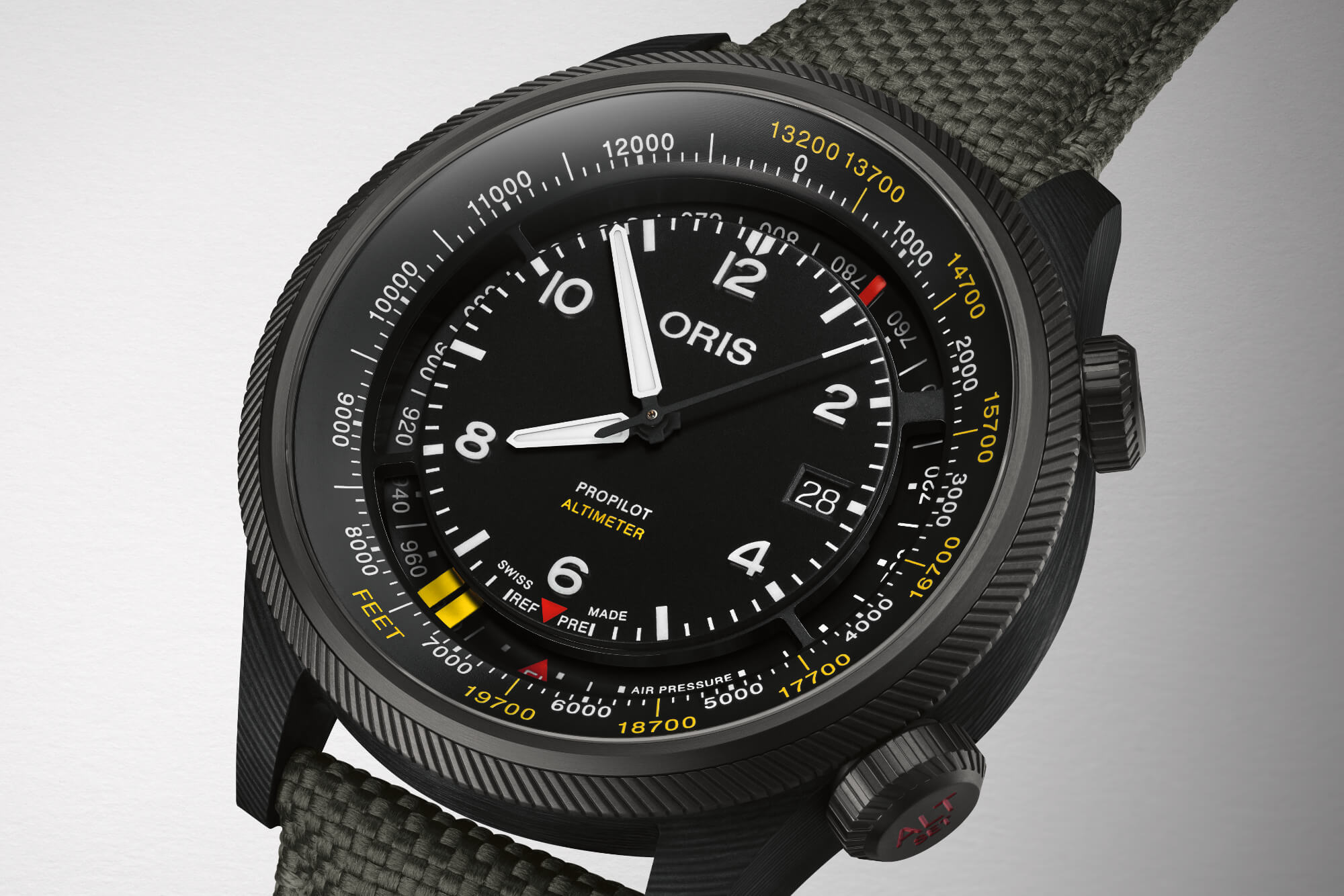 According to Oris, this is the only automatic watch with a mechanical altimeter; I couldn’t find any other current automatic watches with such a complication, so this seems to be correct (Favre-Leuba makes a hand-wound mechanical altimeter). The dial itself is a relatively straightforward three-hand setup with a date at 3 o’clock. It’s the scales around the main dial that sets this watch apart. The watch displays both the barometric pressure and the altitude, the latter up to 6,000m/19,7000ft (it will be available in your choice of meters or feet). To operate the altimeter, you unscrew the 4 o’clock crown to set the base altitude (which you’ll need to know). This will also reveal a red ring on the crown stem, letting you know air is being allowed in; while a membrane prevents air moisture from penetrating the case, this effectively results in the watch losing its water resistance. By allowing air in, the barometric module inside the watch is affected. That module is linked to the two gauges on the dial and produces a readout of the air pressure and altitude. As the watch requires a change in air pressure to determine the altitude, it won’t work in a pressurized environment like a commercial jet but will give you a real-time readout as your altitude changes on a hike, flight in smaller planes, or skydiving, to name a few examples. The black and white dial with red and yellow accents not only looks good but should ensure legibility along with the lumed handset. As Ariel noted in the review of the original ProPilot Altimeter linked above, however, the small font of the gauges means quick readings of the pressure and altitude can be tricky, especially when you’re rattling around in a vintage fighter jet.
According to Oris, this is the only automatic watch with a mechanical altimeter; I couldn’t find any other current automatic watches with such a complication, so this seems to be correct (Favre-Leuba makes a hand-wound mechanical altimeter). The dial itself is a relatively straightforward three-hand setup with a date at 3 o’clock. It’s the scales around the main dial that sets this watch apart. The watch displays both the barometric pressure and the altitude, the latter up to 6,000m/19,7000ft (it will be available in your choice of meters or feet). To operate the altimeter, you unscrew the 4 o’clock crown to set the base altitude (which you’ll need to know). This will also reveal a red ring on the crown stem, letting you know air is being allowed in; while a membrane prevents air moisture from penetrating the case, this effectively results in the watch losing its water resistance. By allowing air in, the barometric module inside the watch is affected. That module is linked to the two gauges on the dial and produces a readout of the air pressure and altitude. As the watch requires a change in air pressure to determine the altitude, it won’t work in a pressurized environment like a commercial jet but will give you a real-time readout as your altitude changes on a hike, flight in smaller planes, or skydiving, to name a few examples. The black and white dial with red and yellow accents not only looks good but should ensure legibility along with the lumed handset. As Ariel noted in the review of the original ProPilot Altimeter linked above, however, the small font of the gauges means quick readings of the pressure and altitude can be tricky, especially when you’re rattling around in a vintage fighter jet.
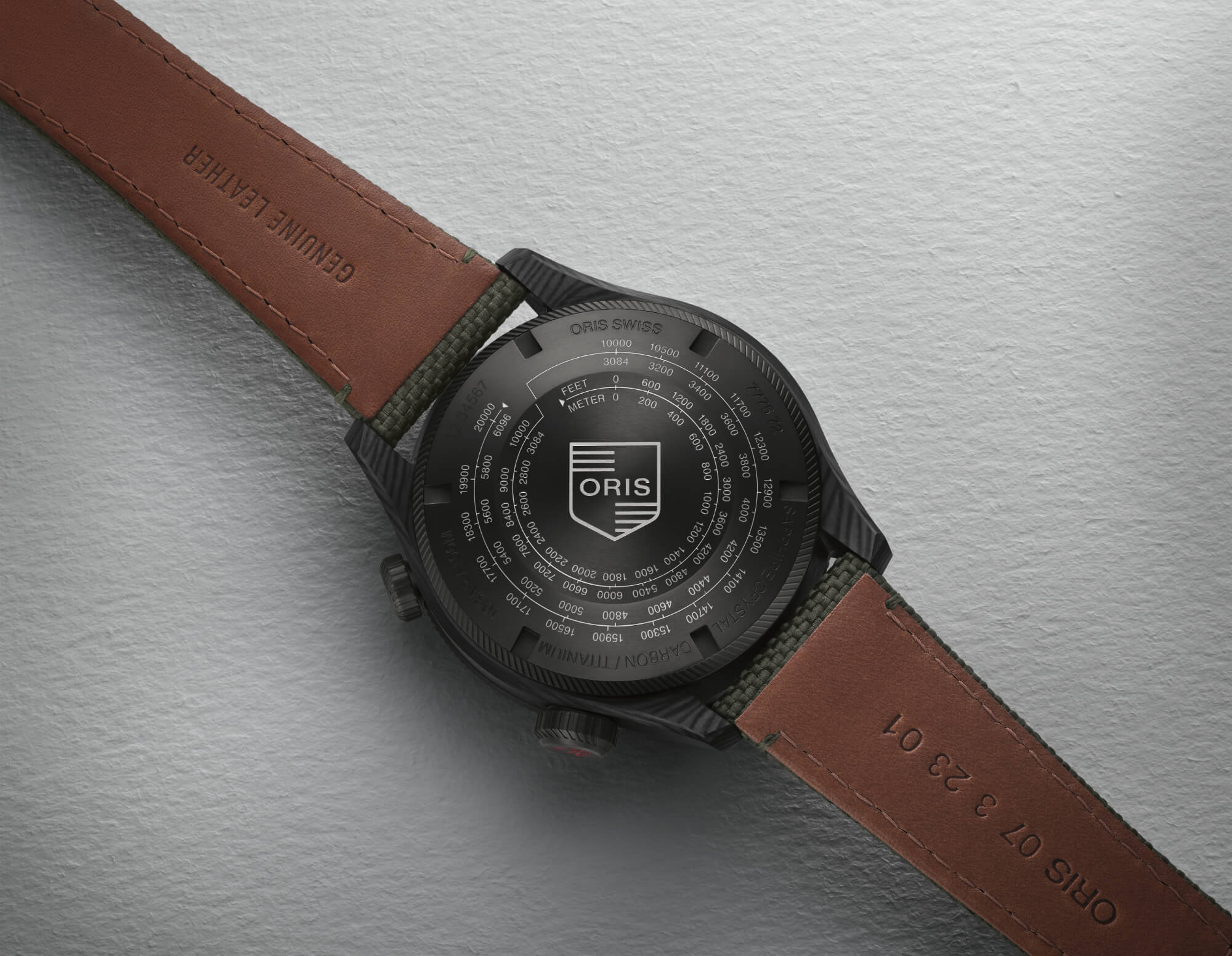 Under the ProPilot Altimeter’s caseback—which has a feet/meters conversion scale—beats the Oris 733, which is a Sellita SW200-1. While it’s not indicated, I’d put good money on it having a red Oris rotor, which is the brand’s thing when it comes to the Sellita movements. The Oris 733 runs at 4hz (28,800vph), with a power reserve of 38 hours, which in this day and age is a bit wanting. As it is, the movement shouldn’t give you any trouble, and its presence on top of the pressure module explains the thickness of the case. If you’re wondering why Oris didn’t go ahead and use one of its in-house calibers, it’s because they’re enormous: the 400 series measures 30mm, while the Oris 733/SW200-1 is 25.6mm. I think we can all agree that even in a carbon/titanium watch, 51.4mm would be too big.
Under the ProPilot Altimeter’s caseback—which has a feet/meters conversion scale—beats the Oris 733, which is a Sellita SW200-1. While it’s not indicated, I’d put good money on it having a red Oris rotor, which is the brand’s thing when it comes to the Sellita movements. The Oris 733 runs at 4hz (28,800vph), with a power reserve of 38 hours, which in this day and age is a bit wanting. As it is, the movement shouldn’t give you any trouble, and its presence on top of the pressure module explains the thickness of the case. If you’re wondering why Oris didn’t go ahead and use one of its in-house calibers, it’s because they’re enormous: the 400 series measures 30mm, while the Oris 733/SW200-1 is 25.6mm. I think we can all agree that even in a carbon/titanium watch, 51.4mm would be too big.
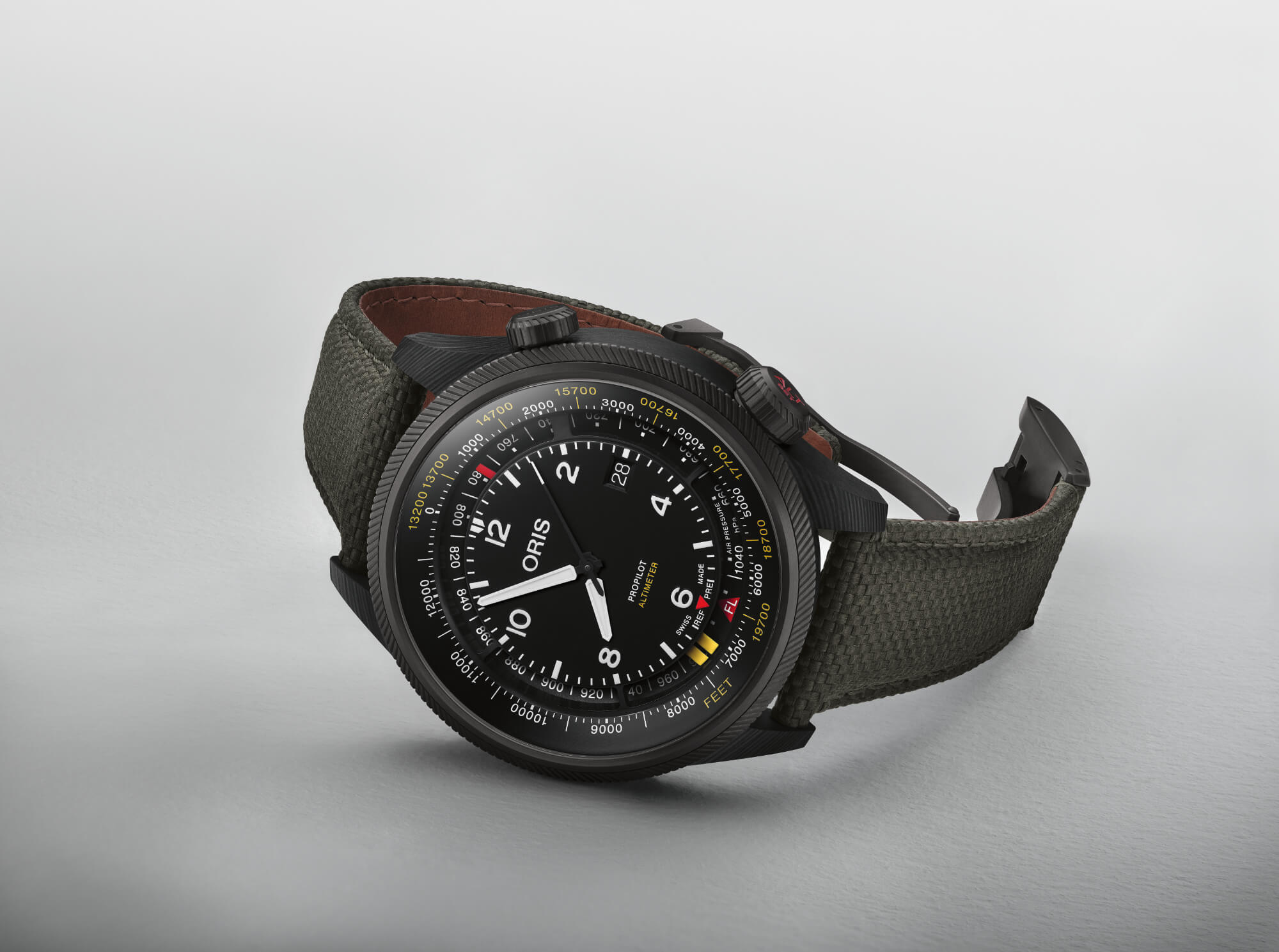 With exceptional legibility and its signature turbine bezel, the ProPilot series has served as the brand’s platform for an array of complications, from chronographs to alarms to a worldtimer that used the bezel to shift the hour hand. It’s hard to argue, though, that the altimeter complication isn’t the coolest, if only because it is so exceedingly uncommon. That Oris is finally getting back to its ProPilot line with a regular production piece is exciting for those, like me, who felt that the brand had been straying a bit. Hopefully, the brand continues to update and expand its ProPilot line with new models and movements. The new Oris ProPilot Altimeter is priced at $6,500 USD and available immediately. For more information, please visit the brand’s website.
With exceptional legibility and its signature turbine bezel, the ProPilot series has served as the brand’s platform for an array of complications, from chronographs to alarms to a worldtimer that used the bezel to shift the hour hand. It’s hard to argue, though, that the altimeter complication isn’t the coolest, if only because it is so exceedingly uncommon. That Oris is finally getting back to its ProPilot line with a regular production piece is exciting for those, like me, who felt that the brand had been straying a bit. Hopefully, the brand continues to update and expand its ProPilot line with new models and movements. The new Oris ProPilot Altimeter is priced at $6,500 USD and available immediately. For more information, please visit the brand’s website.

